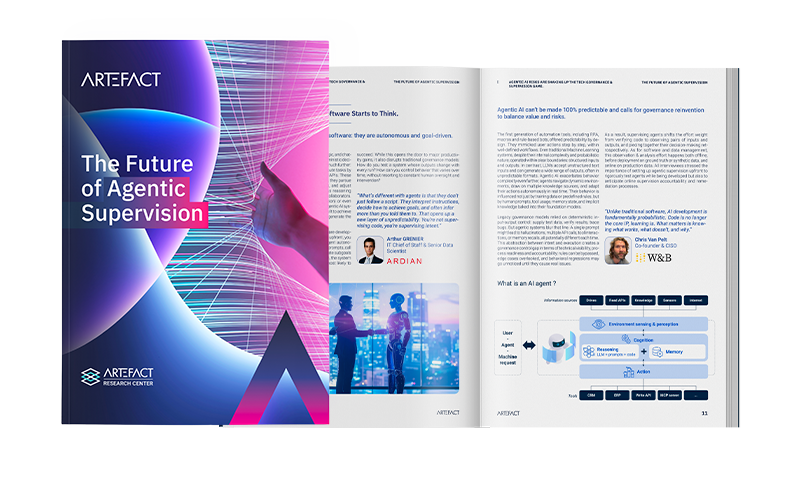Artefact’s earlier study on The Future of Work with AI concluded that repetitive and tedious work will be augmented by agentic AI and transformed into agentic supervision. Following on this study, The Future of Agentic Supervision, takes a deep dive into how organizations can prepare to oversee and manage the performance, safety, and strategic value of these new intelligent systems, and, eventually, reinvent work around agentic AI supervision. This synthesis summarizes the key insights and recommendations from the study, bridging technical and business governance with a practical playbook for companies looking to build trustworthy, high-impact agents.
What makes agentic AI different?
Agentic AI systems are not traditional software. They are probabilistic, meaning their outputs, while strongly influenced by input context, do vary at every run. Traditional software, on the contrary, is driven by deterministic rules, which can be fully trusted if well designed, because they constantly apply the same, invariant and correct logic. The limit of traditional software however, is that it can not solve a new, even slightly different problem. AI agents solve this scope limitation at the expense of reliability. They integrate natural language capabilities with the power to act autonomously across internal tools, APIs, or databases to solve new problems. This flexibility enables impressive value creation across customer support, operations, HR, and procurement.
But agentic AI systems also disrupt long-standing assumptions in software governance. Where traditional code is tested once and deployed with confidence, agents must be deployed with risk in mind, constantly monitored, evaluated, and improved. The future of agentic governance, therefore, is not only about deployment-time certification, it’s also about ongoing supervision at scale.
The central trade-off: Value vs. risk
Enterprises face a core challenge with AI agents: there is no such thing as zero risk with probabilistic logic. As a consequence, AI agent development teams need to deliver value with acceptable risk. On the one hand, highly permissive agents may deliver value but also pose operational, reputational, ethical, or financial risks. On the other hand, highly constrained agents may be safe, preferring shallow and simple responses, but offer limited utility.
This value vs.risk trade-off must be explicitly managed. Enterprises must define what “value” means in context (task success rate, user engagement, productivity gains) as well as which risks must be controlled: hallucination, latency, bias, reputational damage, or cost overruns. Supervision becomes the operational mechanism that tunes this balance at every step of the AI agent lifecycle: at design, development, deployment and run times.
Supervision in three steps: Observe, Evaluate, Act
To achieve this balance, companies need to build agentic supervision around three core capabilities:
- Observation: Capture structured telemetry data—inputs, outputs, tool calls, errors, and human feedback.
- Evaluation: Use quality metrics and risk indicators to assess performance against business-defined objectives and control thresholds.
- Action: Escalate and manage incidents, retrain models, adjust guardrails, or roll back agent updates.
This process, called “active supervision”, mirrors DevOps practices but must be adapted for the probabilistic, evolving nature of AI, and extended beyond the tech teams to encompass business processes and teams (Customer Success, HR, Legal, Operations, etc.).
Supervision starts at an agent’s birth
Agentic governance begins well before deployment. Business and technical teams must collaborate from the exploration phase to define success criteria, identify risk types, and decide on the evaluation strategy. This co-design approach ensures that agents are not only technically robust but also aligned with business priorities from the outset.
In the design phase, teams often need to build “ground truth” datasets that reflect desired agent behavior. These become essential for both training and evaluation. During development, teams must determine go/no-go release thresholds across multiple metrics. Success is no longer binary (e.g., all tests pass); it’s probabilistic (e.g., >90% on task success, <2% toxicity), requiring governance to define what “good enough” looks like.
Supervision doesn’t end at deployment. Continuously monitoring production is essential for evaluating and refining agents. When an incident arises, the business team responsible for manual resolution must feed back the expected correct behavior to the agent team, thereby enriching and improving the ground-truth dataset.
Metrics-based deployment requires business input
A major innovation in agent governance is the idea that agents are released based on multidimensional metric thresholds. This includes traditional performance metrics (accuracy, latency), business metrics (task completion), and risk metrics (toxicity, bias, policy violation).
Critically, the decision to promote an agent to production should not rest solely with technical teams. Business stakeholders must define acceptable risk thresholds and approve deployment criteria. Governance becomes a shared responsibility across AI engineers, product managers, compliance officers, and domain experts.
The role of LLM-as-a-judge
Evaluating LLM-generated outputs can be subjective and time-consuming. That’s where LLM-as-a-Judge techniques come into play. These involve using independent LLMs to score the outputs of other LLMs, evaluating response relevance, factuality, or tone.
While some may be skeptical about using AI to judge AI, experience shows that independent models can reliably assess generated outputs. However, the condition for a reliable LLM-as-a-Judge is simplicity and only asking for binary judgements like “acceptable or not”. In other words, “simple AI” generating specific binary criteria is very effective in judging “complex AI” generating lengthy texts. This technique accelerates evaluation pipelines and reduces reliance on human raters for every case, though human judgment remains essential in high-stakes reviews.
Guardrails are safety nets to be set up from Day 1
Evaluation is an essential component of guardrails that prevent known failure modes with proactive controls. Guardrails may be applied at the input level (e.g., filtering prompt injections), at the output level (e.g., blocking unsafe completions), or via intermediary logic (e.g., tool access conditions).
But guardrails come with trade-offs. Too strict, and they cause rejection loops or silent failures that degrade UX. Too loose, and risk tolerance is exceeded. Guardrails must evolve with the agent’s capabilities and business maturity, starting with strict guardrails to ensure trust, and gradually loosening them to improve value while controlling risks. Therefore, designing, testing, and tuning guardrails is not a one-time task, it’s part of the ongoing supervision lifecycle.
Incident handling: The rise of human supervisors
Even with well-instrumented systems, incidents are inevitable. A critical part of agentic supervision is detecting failures with guardrails and escalating them to human teams. These may include safety violations, task failures, ambiguous outputs, or tool misuse.
The supervision job must be designed to be engaging, sustainable, and productive. Front-line supervisors need:
- Rich, structured context: full trace logs, trigger explanations, user metadata.
- Streamlined interfaces: decision workflows, default recommendations, fallback options.
- Smart routing: assign escalations based on expertise and load balancing.
- Fatigue management: ensure alert volume and complexity are manageable.
When done well, supervision becomes a virtuous loop: human decisions feed into retraining datasets and refine guardrail policies. Supervision isn’t just about containment, it drives long-term agent improvement.
Tooling: The AgentOps stack
To operationalize all this, enterprises must adopt a new class of tools: the AgentOps stack. These include platforms like LangSmith, Langfuse, DeepEval, Ragas, PRISM Eval, Giskard, Arize, Weights & Biases and Robust Intelligence for:
- Observability
- Evaluation
- Ground truth annotation
- Experiment tracking
- Guardrail orchestration
Most platforms combine these features but each has specific strengths. Some focus more on observability, others on agentic deployment, others on a risk vertical like security. These tools mirror DevOps and MLOps platforms but are adapted for the specific needs of agentic systems. We recommend integrating these tools with existing CI/CD pipelines and data platforms to maintain traceability and reuse.
Governance is a team sport
One of the study’s key conclusions is that agent governance cannot be the sole responsibility of AI engineers. Business teams must co-design guardrails, define acceptable risk thresholds, and participate in escalation protocols. Legal, compliance, marketing, and support must have access to dashboards tailored to their risks.
This implies a new form of governance, one that blends AI observability with business accountability. We recommend organizing supervision teams not by agent but by risk type (e.g., legal, operational, brand), allowing for horizontal oversight across multiple agents. Without such an organization it will be difficult to scale agentic trust.
The role of DataOps
Agentic AI reveals the flaws in enterprise data quality like few systems before. Retrieval-based agents often surface stale, sensitive, or irrelevant data if underlying repositories aren’t curated. That’s why agentic governance must go hand-in-hand with DataOps. Incidents must be traced not just to the agent’s prompt logic but to the data pipelines feeding it.
AgentOps, when done right, strengthens enterprise data governance. And vice versa.
A practical playbook for getting started
To help companies move from theory to practice, we offer four recommendations:
- Start with real projects, not prototypes: Focus governance efforts on high-value agents intended for production. Build real systems, not throwaway demos, to uncover operational realities early.
- Think developer-first in tooling: Choose Observability tools that support engineering workflows. Business dashboards are helpful, but developer adoption is critical to collecting quality metadata.
- Clarify risk ownership: Define which functions own which risks. Who is accountable for security, privacy, bias, or UX degradation? Establish escalation paths and sign-off rules.
- Unify AgentOps with DataOps: Treat agents and data pipelines as two sides of the same coin. Jointly supervise data quality and agent behavior to diagnose root causes of incidents.
Conclusion: From supervision to strategic advantage
Agentic supervision is not just about preventing harm, it’s about enabling trust at scale. By establishing shared metrics, robust tooling, and collaborative protocols, organizations can unlock the full value of agentic systems while keeping risks under control.
Agent governance will evolve rapidly. But its foundation is timeless: clarity, collaboration, and continuous learning. Enterprises that embrace this discipline early will not only avoid costly mistakes, they’ll build a durable competitive advantage.
 BLOG
BLOG
